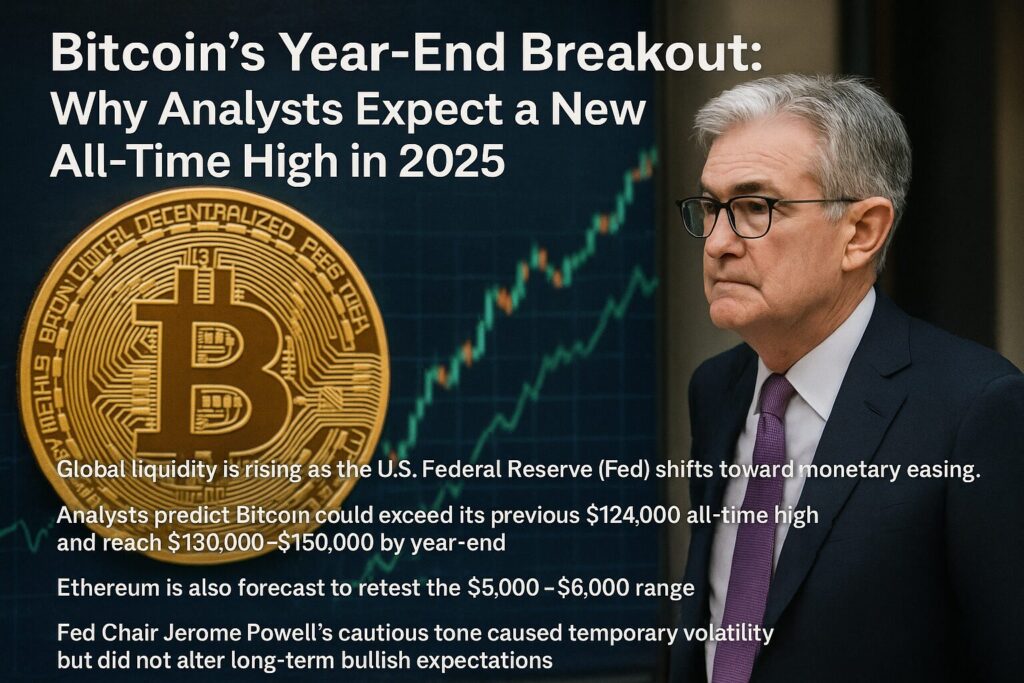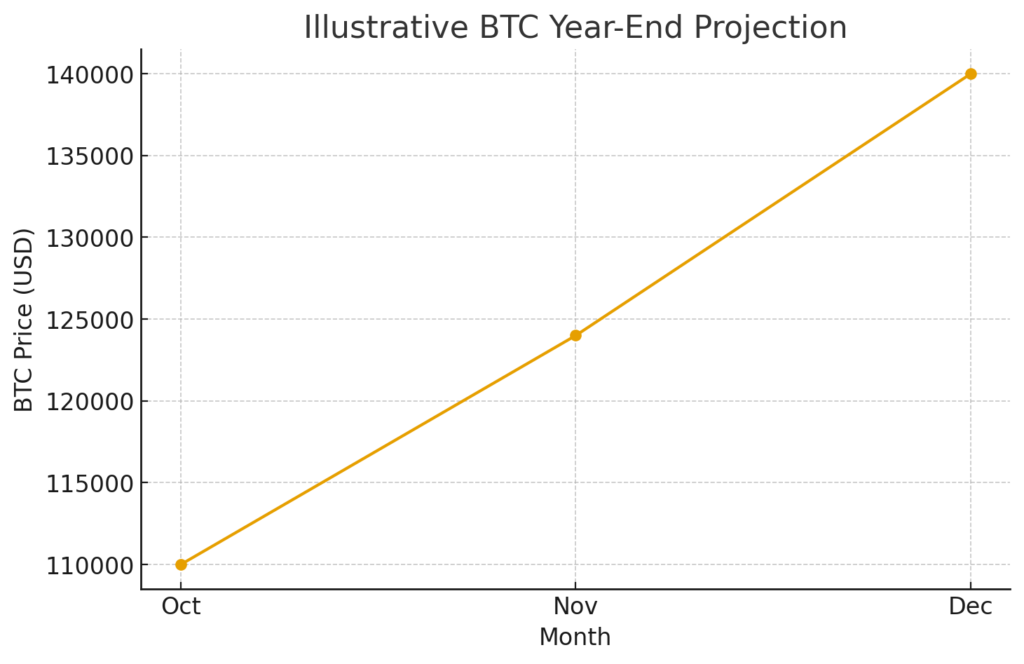
Main Points:
- Global liquidity is rising as the U.S. Federal Reserve (Fed) shifts toward monetary easing.
- Analysts predict Bitcoin could exceed its previous $124,000 all-time high and reach $130,000–$150,000 by year-end.
- Ethereum is also forecast to retest the $5,000–$6,000 range.
- Fed Chair Jerome Powell’s cautious tone caused temporary volatility but did not alter long-term bullish expectations.
- Policy clarity, including pending U.S. crypto-market-structure legislation, is adding confidence to long-term investor positioning.
1. Introduction: A Market Primed for a Breakout
Bitcoin is approaching what analysts believe to be one of the strongest macro-tailwinds in recent crypto history. A combination of improving global liquidity, easing Federal Reserve policy, and increased appetite for risk assets has ignited the possibility that Bitcoin could reclaim and surpass its previous all-time high of $124,000—entering a new price discovery phase before the end of 2025.
The Federal Reserve’s recent actions and tone are at the heart of this shift. On October 29, 2025, the Fed announced its second rate cut of the year, lowering the federal funds target range to 3.75%–4.00% and signaling that quantitative tightening (QT) would officially end on December 1.
This combination—lower interest rates and the termination of balance-sheet reduction—has historically served as a powerful accelerant for Bitcoin rallies.
Matt Mena, crypto research strategist at 21Shares, summarized the situation as follows:
“We are slightly risk-on, and we see a credible path for Bitcoin to break its previous all-time high by year-end… Bitcoin could exceed $124K decisively and finish the year in the $130K–$150K range, while Ethereum trades in the $5K–$6K band.”
His comments point to a carefully aligned environment of liquidity, sentiment, regulatory clarity, and risk-rotation—all crucial ingredients for a major crypto advance.
2. Federal Reserve Easing: The Engine Behind Bitcoin’s Momentum
A Turning Point in U.S. Monetary Policy
The Federal Reserve’s shift toward easing is pivotal for Bitcoin’s macro outlook. The Fed’s decision to cut rates for the second time in 2025 marks an inflection point after years of fighting inflation with aggressive tightening.
Why this matters for Bitcoin:
- Lower interest rates reduce yields on cash and bonds, pushing investors into higher-risk, higher-return assets such as crypto.
- Ending QT removes liquidity pressure from financial markets, historically benefiting Bitcoin.
- Global funds tend to rotate into scarce, non-sovereign assets during easing cycles.
The Role of Global Liquidity
Global liquidity indicators—such as central bank balance sheets, global M2 money supply, and USD liquidity indices—have been expanding since mid-2025.
Historically:
- Bitcoin price has shown a strong correlation with global liquidity expansions.
- Each major Bitcoin bull cycle has begun shortly after liquidity bottoms.
The present environment matches these patterns almost perfectly.
3. Short-Term Volatility: Powell’s Cautious Remarks
Fed Chair Jerome Powell introduced uncertainty during the FOMC press conference when he stated:
“It is not a foregone conclusion that we will need to cut rates again in December… We have made no decision.”
This hawkish tone temporarily shook markets:
- Bitcoin briefly fell below $110,000, touching $109,800.
- The Dow Jones dropped nearly 200 points.
- Risk assets broadly cooled.
However, analysts interpreted Powell’s statement as data-dependent, not a reversal. Markets continue to expect easing to continue into year-end barring unexpected inflation spikes.
In short:
A momentary dip, not a macro trend change.
4. Ethereum and Altcoins: Beneficiaries of the Liquidity Wave
Ethereum could be one of the strongest beneficiaries of the upcoming liquidity rotation.
Analysts expect:
- ETH to retest the $5,000 psychological level,
- With potential to reach $6,000 on strong sentiment.
Why Ethereum stands to gain:
- Liquidity-driven cycles amplify smart-contract ecosystem assets.
- Staking yields look more attractive when Treasury yields decline.
- Policy clarity around U.S. digital asset legislation reduces structural uncertainty for institutional investors.
This creates room not only for Bitcoin and Ethereum but also for mid-cap assets, infrastructure tokens, and AI-related cryptocurrencies to expand significantly.
5. Policy and Regulatory Clarity: A Silent Tailwind
Matt Mena also referenced improving structural conditions:
“A constructive regulatory backdrop is finally beginning to take shape as long-awaited clarity bills and crypto market-structure legislation move forward into 2026.”
The crypto industry has long struggled with:
- Undefined classifications for tokens
- Conflicting regulatory interpretations
- Unclear custody and reporting requirements
Now, with:
- Potential U.S. legislative breakthroughs
- Greater global coordination
- Institutional off-take increasing
…investors have renewed confidence that the next bull cycle will be more stable and broader than previous cycles.
6. Why Analysts Expect a New All-Time High
Key Drivers Supporting the Bullish Outlook
- Global Liquidity Surge
Liquidity expansion historically leads Bitcoin upward due to its fixed supply and scarcity narrative. - Monetary Easing Cycle
Lower rates and the end of QT reduce macro pressure on Bitcoin and encourage risk-taking. - Growing Institutional Demand
Spot Bitcoin ETFs, custody solutions, and compliance frameworks have made institutional entry straightforward. - Strong Investor Sentiment
Crypto fund inflows have risen for several consecutive weeks, mirroring early-cycle bull conditions. - Regulatory Clarity
Reduces legal uncertainty and unlocks new capital sources such as pension funds and sovereign wealth funds.
7. Recent Market Dynamics from External Sources (2024–2025 Trends)
To provide additional context, here are broader macro trends from publicly available financial and crypto-market sources:
1. U.S. Money Supply Expansion
Since early 2025, U.S. M2 growth has notably accelerated. Bitcoin has historically tracked M2 increases with a lag of 3–6 months.
2. ETF-Driven Demand
Spot Bitcoin ETFs in the U.S., Europe, and Asia continue to add net inflows.
Analysts estimate ETF programs alone may absorb ~600,000 BTC annually, far above new supply post-halving.
3. Declining Real Yields
With rate cuts and slowing inflation, real yields are falling—typically bullish for non-yielding stores of value like Bitcoin.
4. AI and Tokenization Themes
Large asset managers like BlackRock and Fidelity have highlighted:
- Tokenized funds
- AI-assisted trading
- Intelligent blockchain settlements
These trends are generating spillover interest into crypto infrastructure assets.
8. Price Targets for Bitcoin and Ethereum
| Asset | Analyst Target Range (Year-End) |
|---|---|
| Bitcoin (BTC) | $130,000–$150,000 |
| Ethereum (ETH) | $5,000–$6,000 |
These projections depend on:
- Absence of inflation surprises
- Continued liquidity expansion
- Avoidance of geopolitical shocks
- Successful passage of U.S. crypto-market bills
However, even with uncertainties, both assets remain structurally bullish.
9. FAQ
Why do analysts expect Bitcoin to reach a new all-time high soon?
Because global liquidity is increasing, the Fed is easing, and investors are rotating into risk assets.
How does the Fed’s latest shift affect crypto?
Rate cuts and the end of QT historically raise market liquidity, which supports Bitcoin and Ethereum.
What are the price targets?
Bitcoin: $130K–$150K
Ethereum: $5K–$6K
Will the Fed cut again before year-end?
Powell was cautious, but analysts say data is favorable and a cut remains possible.
10. Chart Insertion (BTC Projection)

11. Conclusion
The alignment of macro liquidity, regulatory advancement, institutional adoption, and improving market sentiment suggests that Bitcoin may be approaching one of the strongest year-end setups in years. Short-term volatility will continue, especially around Fed communications, but the medium-term path remains decisively upward.
If current macro conditions persist, Bitcoin reclaiming and surpassing its prior $124,000 record appears increasingly plausible, opening a potential run toward $130,000–$150,000. Ethereum stands to benefit in parallel, supported by liquidity flows, sentiment shifts, and ecosystem maturity.
For investors seeking new opportunities—whether in flagship assets like BTC and ETH or emerging altcoins tied to infrastructure and real-world utility—the coming months may define the next major crypto cycle.

